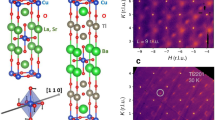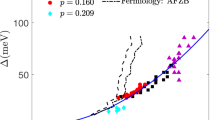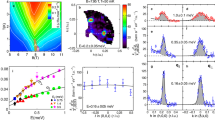Abstract
THE superconducting transition temperature, TC, defines the point at which the free energies of the superconducting and normal states of a material become equal. Just above TC, thermodynamic fluctuations produce small, transient regions of the superconducting state, giving rise to an anomalous increase in the normal-state conductivity known as paraconductivity. This situation is analogous to the fluctuating regions of correlated spins found near the Curie-Weiss transition in ferromagnets. Such fluctuations are of theoretical significance in that they provide a direct probe of critical phenomena in general, and a stringent test of scaling theories, which describe the approach to the critical point. Paraconductivity effects are strongly dependent on the dimensionality of the system, although for conventional superconductors, three-dimensional fluctuation conductivity has to our knowledge never been observed. Here we report the observation of pure, three-dimensional paraconductivity in single crystals of the recently discovered1 superconductors K3C60 and Rb3C60. In addition to probing the critical state near Tc, these measurements allow the indirect determination of the residual, normal-state resistivity.
This is a preview of subscription content, access via your institution
Access options
Subscribe to this journal
Receive 51 print issues and online access
$199.00 per year
only $3.90 per issue
Buy this article
- Purchase on Springer Link
- Instant access to full article PDF
Prices may be subject to local taxes which are calculated during checkout
Similar content being viewed by others
References
Haddon, R. C. et al. Nature 350, 320 (1991).
Xiang, X.-D. et al. Science 256, 1190 (1992).
Ogata, H. et al. Jpn J. appl. Phys. 31, L166 (1992).
Aslamasov, L. G. & Larkin, A. I. Phys. Lett. A26, 238 (1968).
Skocpal, W. J. & Tinkham, M. Rep. Prog. Phys. 38, 1049 (1975).
Maki, K. Prog. theor. Phys. 39, 887 (1968); 40, 193 (1968).
Thompson, R. S. Phys. Rev. B1, 327 (1970); Physica 55, 296 (1971).
Maki, K. & Thompson, R. S. Phys. Rev. B39, 2767 (1989).
Appel, J. Phys. Rev. Lett. 21, 1164 (1968).
Schmidt, H. Z. Phys. 216, 336 (1968).
Hou, J. G., Crespi, V. H. Xiang, X.-D., Zettl, A. & Cohen, M. L. Phys. Rev. Lett. (submitted)
Sparn, G. et al. Phys. Rev. Lett. 68, 1228 (1991).
Rotter, L. D. et al. Nature 355, 532 (1992).
Gelfand, M. P. & Lu, J. P. Phys. Rev. B46, 4367 (1992).
Reggiazi, L. & Vaglio, R. Phys. Rev. B44, 9541 (1991).
Author information
Authors and Affiliations
Rights and permissions
About this article
Cite this article
Xiang, XD., Hou, J., Crespi, V. et al. Three-dimensional fluctuation conductivity in superconducting single crystal K3C60 and Rb3C60. Nature 361, 54–56 (1993). https://doi.org/10.1038/361054a0
Received:
Accepted:
Issue Date:
DOI: https://doi.org/10.1038/361054a0
This article is cited by
-
Superconductivity and electrical resistivity in alkali metal doped fullerides: Phonon mechanism
Bulletin of Materials Science (2005)
-
Optical measurements of the superconducting gap in single-crystal K3C60 and Rb3C60
Nature (1994)
-
Production of single-crystal K3C60
Journal of Superconductivity (1994)
-
Normal-state transport properties of fullerene superconductors
Journal of Superconductivity (1994)
Comments
By submitting a comment you agree to abide by our Terms and Community Guidelines. If you find something abusive or that does not comply with our terms or guidelines please flag it as inappropriate.



